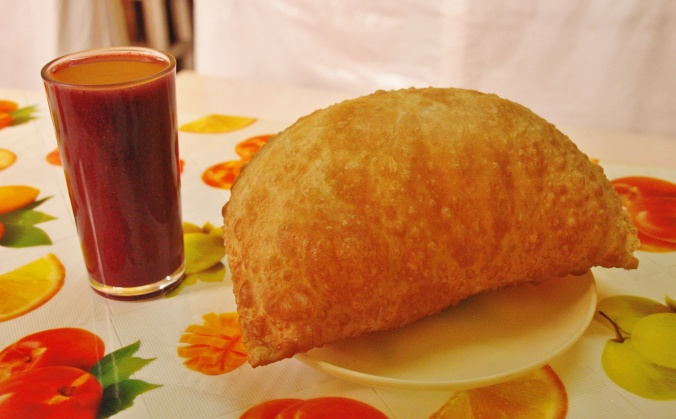A trek into the Colca Canyon is no small feat; plunging to a depth of 13,650’, it is the second deepest canyon in world (the first being Cotohuasi Canyon in the same district in Peru). My boyfriend and I set out on a circuit through the canyon and after three days of intense down and uphill trails, my knees were certainly paying the price. A major source of relief came from the natural hot springs that are a feature of the tiny hillside village of Llahuar where we stopped for a night on our way through. Soaking in the thermal baths soothed our aching muscles and rejuvenated us for the days to come.
One of the highlights of our time there was a visit to some botanical gardens that are tended by the owners of the Llahuar Lodge. After breakfast and a second dip in the springs, a kind woman named Angie agreed to take us out to the ancient rock terraces to see them for ourselves. She led us on a tiny trail until we came to a cultivated area clinging to the hillside overlooking the Rio Colca that flows through the canyon below. As we walked along the trail past each garden patch, she would point out various plant species and talk about their uses to the local people.

I was particularly intrigued by the cactus species that we had been continuously surrounded by as we made our way through the canyon. Coming from the northernmost region of the U.S., cacti are completely foreign to me and I was eager to learn more about them. The most prominent type being grown in dense, tangled patches was a species that she called “tuna,” but is also known as the “prickly pear.” It is characterized by a stunted, flat, rounded appearance, both with and without spines, and occasional yellow flowers. The color of the fruit depends on the minerals in the soil ranging from yellow to red, and it is skinned before consuming the juicy pulp inside; the leaf can also be used as a laxative. Additionally, the tuna cactus attracts small parasitic insects called “cochinilla” which are desired by Peruvians for their vibrant red pigmentation. The Incas originally discovered this red dye and used it to paint their tools, textiles, ceramics, instruments, and even as a ceremonial face paint. In more recent years, people began infecting their tuna crops with the parasites to harvest the red pigment to sell to exporting companies for use in paint and makeup, which is why they’re harvested today.
Some other cactus species that we came across were the “sancayo,” which is a flowering plant that produces fruit sold in the markets, and the “San Pedro,” which has many uses but is most commonly recognized as a powerful hallucinogen. The sancayo fruits were out of season while we were there, but the plant itself towers at about 3 meters tall and is covered in wiry spines. When ripe, it has a large, round, yellowish-green fruit with black seeds. Both the sancayo and San Pedro cactuses have sap that was traditionally made into a shampoo. The San Pedro cactus contains large concentrations of mescaline, thus accounting for its hallucinogenic properties. To this day it continues to be a facet of shamanic healing rituals performed in the Andean region. As a medicine, it has been used to lower fever and treat kidney disorders. The juice can be topically applied to treat wounds or skin diseases, and also has several uses in veterinary care.
The botanical gardens were home to some fruit trees including “durazno” (peach), “manzana” (apple), and “palta” (avocado). All were out of season at the time, but we could see some immature fruit beginning to develop. There was also alfalfa growing around the area as a forage crop to feed animals.
One of the more interesting fruits to be seen was the “pakay” tree, which held an abundance of large seed pods sometimes referred to as “ice cream beans.” Angie gave us several of the pods to crack open and taste, and the result was quite bizarre. Inside were multiple large seeds lined in a row and covered in white, velvety fur. Once you put the white mound into your mouth, the seed comes right off and you spit it out to enjoy eating the sweet pulp. Technically pacay is a legume tree, and the seeds are relatives of other beans, peas, lentils, and peanuts. They are multi-purpose crops because farmers can sell the fruit and use the tree’s massive shade cover to cultivate coffee and cacao plantations. In some places pacay has even been used as a percussion instrument when the pod is dried with the seeds left inside to create a shaker.
The “molle” is a medicinal evergreen tree that has been used as an insect repellant and a healing agent for wounds and infections due to its antibacterial and antiseptic properties. Some believe it to be useful as an antidepressant, diuretic, and for menstrual disorders. Its small clusters of red berries can be made into a drink or sold as peppercorns, while the rough bark is used for firewood, and the leaves were historically used to dye Andean textiles.

“Eucalipto” or eucalyptus was one of the few plants I recognized from its fragrant and distinctive scent. Many are familiar with it in aromatherapy, but the oil from the plant also has medicinal uses as a natural anti-bacterial, anti-fungal, anti-microbial, anti-viral, anti-inflammatory, anti-septic, deodorant, and decongestant. Angie said that they mostly use it for respiratory issues such as colds, coughs, asthma, bronchitis, and congestion problems. When applied topically, it is also beneficial for cuts, wounds, burns, sores, abrasions, insect bites, and rheumatism or muscle pain. Eucalyptus can be found in mouthwash, toothpaste, and other dental care products, as well as soaps, detergents, and cleaners. Not to mention is just smells heavenly!
































































































